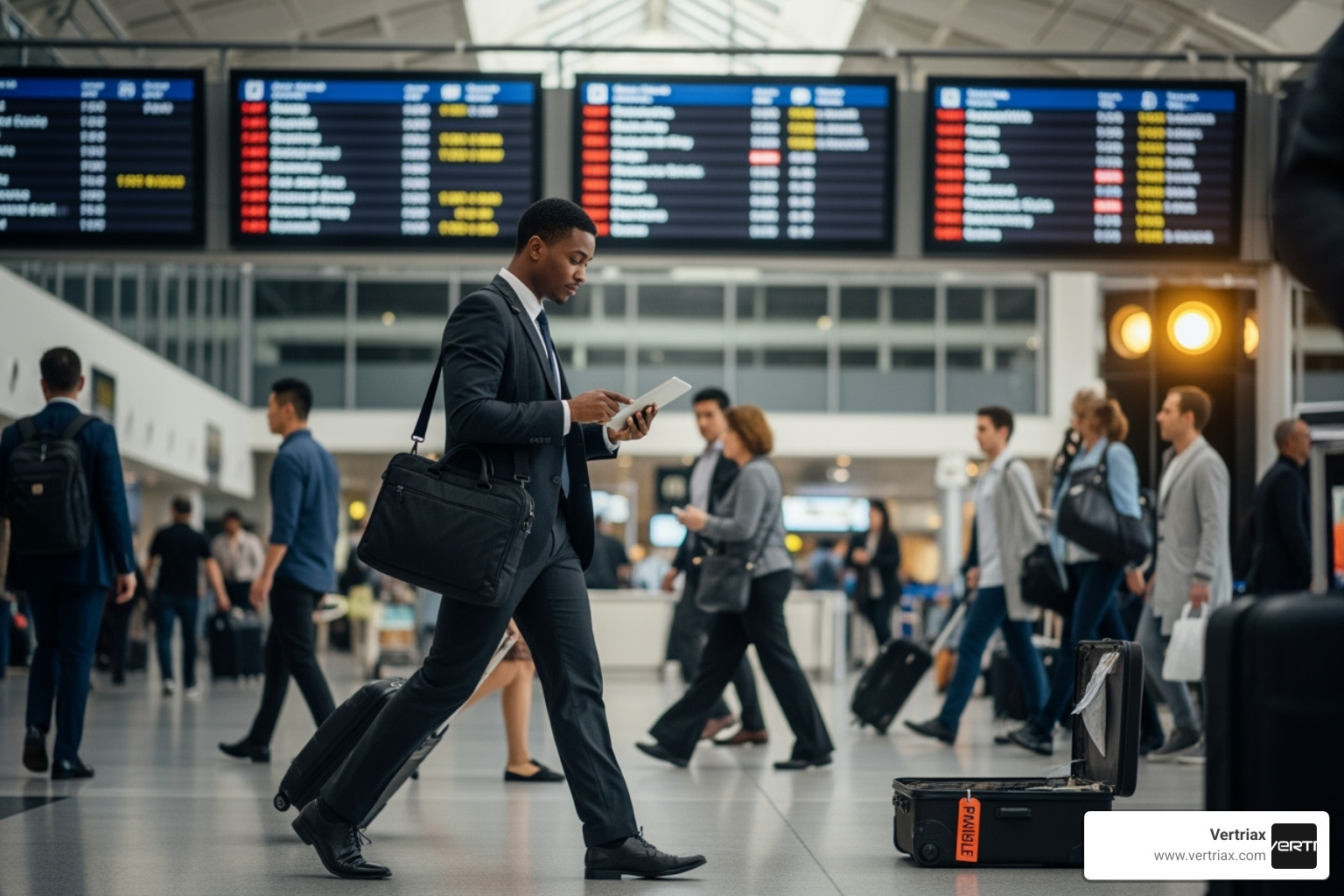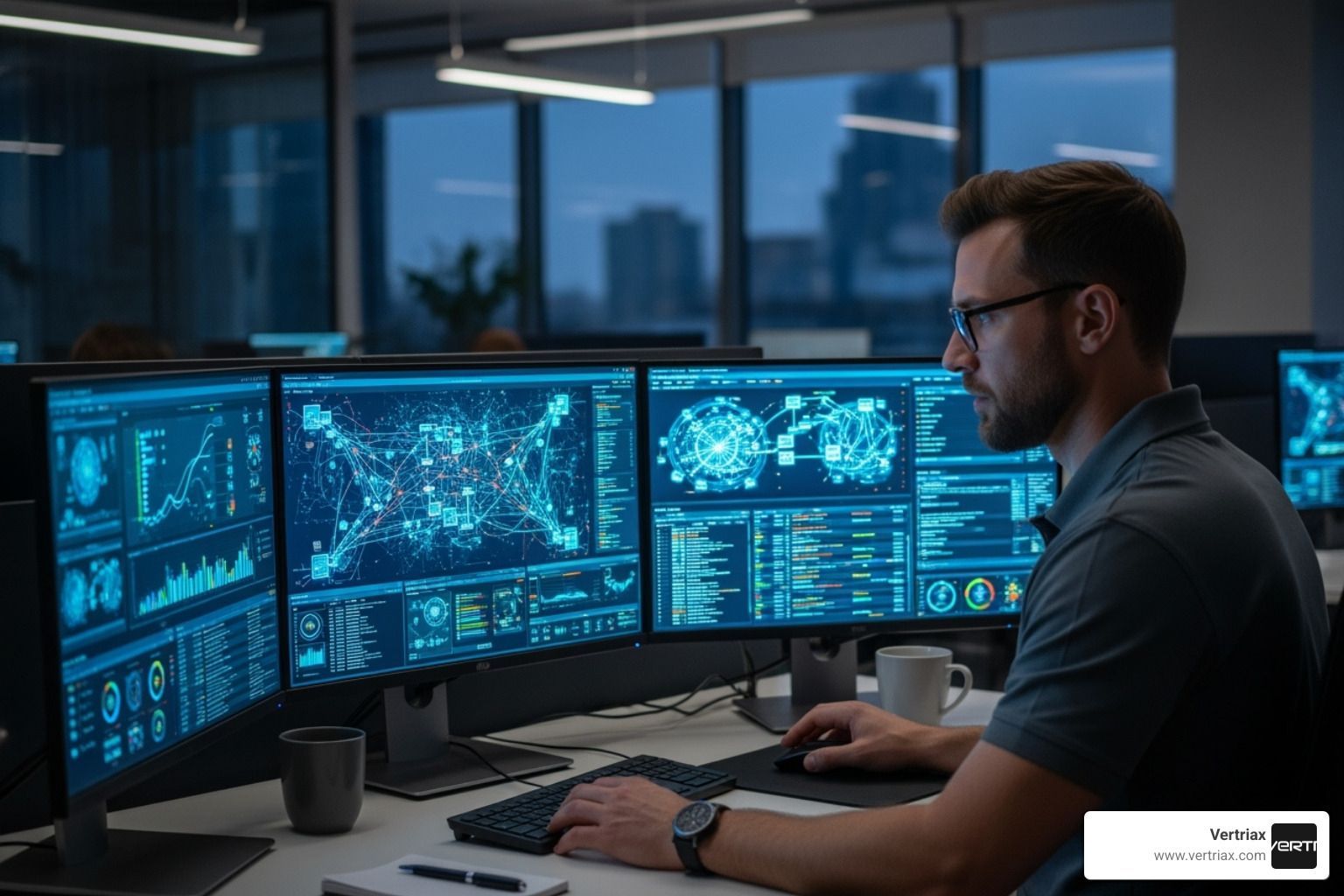Risky Business? Mastering Corporate Travel Risk Management
Introduction: Why Travel Risk Management is a Non-Negotiable Business Imperative

Corporate travel risk management is a proactive system for identifying, assessing, and mitigating threats to employees during business travel. It involves risk assessment, pre-travel preparation, real-time monitoring, and incident response to protect traveling employees from a wide range of health, security, and logistical risks.
As business travel surges past pre-pandemic levels, the risk landscape has become more complex. Today's travelers face a constant stream of potential threats, from geopolitical instability and natural disasters to health crises and cyberattacks. This new reality demands a comprehensive approach to traveler safety.
Organizations have a legal and moral duty of care to protect their people on the road. A robust travel risk management program is not just about compliance; it's about ensuring business continuity, protecting your reputation, and enabling confident, productive travel. It's about safeguarding your most valuable asset: your people.
As President & CEO of Vertriax, I've seen how effective TRM can mean the difference between a successful trip and a crisis. This guide will show you how to build a program that protects both your travelers and your organization.
The Anatomy of an Effective Travel Risk Management (TRM) Program
An effective corporate travel risk management program is a continuous cycle, not a one-time project. The best programs follow a proactive framework with four phases: assess, prepare, monitor, and learn. Success requires collaboration between HR, Security, Legal, and Management to ensure everyone is aligned.
At Vertriax, we often begin this process with comprehensive evaluations to identify vulnerabilities. Our Security Assessment services help establish a baseline for building a resilient program.
Phase 1: Proactive Risk Assessment
This phase starts by identifying potential threats, from major events like political instability to everyday risks like transportation strikes or health hazards. We then evaluate these risks using a matrix that considers both likelihood and impact. This is informed by deep destination intelligence , covering local crime rates, healthcare quality, and cultural norms. A crucial, often-missed step is assessing traveler-specific vulnerabilities , as risks can differ based on gender, identity, or health conditions. We test our plans with crisis response exercises to identify gaps before a real incident occurs.
Phase 2: Mitigation and Pre-Travel Preparation
With risks identified, we create clear travel policies that act as a roadmap for safe travel, covering booking, expenses, and risk-level protocols. Pre-travel briefings translate policy into practical, destination-specific guidance. Security awareness training teaches situational awareness and practical skills for handling common issues like a lost passport or a medical problem. An itinerary approval process ensures every trip aligns with our risk assessments, and we verify that travelers have comprehensive insurance coverage , including for medical emergencies, security incidents, and trip disruption.
At Vertriax, we ensure your people feel supported and protected. Learn more about our Travel Security Services: Expert Protection for Global Journeys.
Phase 3: Real-Time Monitoring and Incident Response
When the unexpected happens, real-time monitoring is critical. Traveler tracking provides situational awareness, allowing us to locate and assist employees in a crisis. Real-time alerts notify travelers of developing situations, from political unrest to natural disasters, with clear guidance. Our 24/7 support provides multilingual medical and security assistance, ensuring help is always available. A robust emergency communication plan uses mass notification systems to quickly reach affected travelers, while a dedicated crisis management team and predefined evacuation protocols are ready to manage serious incidents.
Vertriax's Security Monitoring Services provide this crucial oversight for a swift and effective response.
Phase 4: Post-Trip Review and Analysis
The program improves through continuous learning. After a trip, incident debriefing helps us analyze what happened and how we could improve our response. We actively solicit traveler feedback for on-the-ground insights that intelligence reports can't provide. This information feeds into regular policy reviews to ensure our program evolves with the changing world. By identifying lessons learned from every trip, we continuously refine our TRM program, making it more resilient and effective at protecting our people and enabling successful business operations.
Navigating the Modern Risk Landscape: Key Threats to Business Travelers
The world has become a more complex place for business travelers. Proactive corporate travel risk management requires anticipating situations and understanding that risks fall into several distinct categories, as there are virtually no "zero-risk" destinations anymore.
Security and Geopolitical Risks
These threats can escalate quickly and have serious consequences. They include:
- Terrorism and civil unrest: Unpredictable events that can disrupt transportation and endanger travelers.
- Political instability: Can lead to sudden border closures or protests, trapping travelers.
- Crime: The most common threat, ranging from petty theft to violent assault. Business travelers can be targets.
- Kidnapping: A severe threat in certain high-risk regions, requiring specialized protection.
- Cybersecurity threats: Using public Wi-Fi or hotel business centers can expose sensitive company data to breaches.
Vertriax's Executive Protection services are designed to mitigate these complex security challenges for your most valuable personnel.
Health and Medical Risks
Health issues can easily derail a business trip. Key risks include:
- Pandemics and disease outbreaks: Global or localized health crises can shut down travel and pose serious health risks.
- Inadequate medical facilities: A major concern in many destinations, especially for travelers with chronic conditions.
- Mental health and well-being: The stress of travel, isolation, and jet lag can take a significant toll.
- Food and water safety: Contamination can lead to illness, which is more dangerous when far from home.
- Vaccination requirements: Evolving rules are essential for both health and legal entry into many countries.
Environmental and Logistical Risks
Natural and man-made disruptions can strand travelers and create safety hazards.
- Natural disasters: Earthquakes, hurricanes, and wildfires can strike with little warning, severing communication and making evacuation difficult.
- Extreme weather: Heat waves or snowstorms can shut down transportation networks and create health risks.
- Transportation disruptions: Airline strikes and system failures are increasingly common, causing costly delays.
Personal and Identity-Based Risks
Risks are not the same for everyone. A comprehensive TRM program must account for individual traveler characteristics.
- Female travelers may face heightened security concerns or cultural restrictions in certain regions.
- LGBTQ+ travelers must be aware of local laws and social attitudes, as same-sex relationships are criminalized in many countries. Check resources like this map of criminalization before travel.
- Religious, ethnic, health, or disability considerations require customized planning to ensure safety and access to necessary facilities.
Fulfilling Your Duty of Care with a Robust Corporate Travel Risk Management Strategy
Sending employees on business trips comes with a profound responsibility for their safety, known as Duty of Care . This is the heart of corporate travel risk management —a moral and legal obligation to protect employees from foreseeable harm. Neglecting this duty can lead to severe legal liabilities, financial penalties, and reputational damage. More importantly, it erodes employee trust.
A robust TRM strategy goes beyond basic compliance. It demonstrates a proactive commitment to safety, which boosts traveler confidence and productivity. A comprehensive program with pre-travel briefings, real-time monitoring, and 24/7 support creates a reliable safety net. The ISO 31030 standard provides a globally recognized framework for achieving this level of excellence.
Understanding Legal Duty of Care
Legal Duty of Care is the obligation to take reasonable steps to ensure employee health and safety during business travel. What is considered "reasonable" and "foreseeable" depends on the destination and context. Courts have consistently ruled that ignorance is not a defense; organizations are expected to assess risks and prepare travelers accordingly. Failure to do so can result in lawsuits and significant financial damages. Protecting your organization requires documenting your risk assessments, traveler communications, and incident responses to prove you have taken all reasonable steps to ensure employee safety.
Leveraging ISO 31030 for a Best-in-Class Program
For organizations committed to excellence, the ISO 31030:2021 standard is the gold standard framework. Published by The International Organization for Standardization , it provides structured, industry-specific guidance for managing travel risks. Aligning with ISO 31030 offers a systematic approach that ensures no detail is overlooked, establishing your program as a global benchmark for TRM .
The standard's key principles emphasize that travel risk must be managed with the same rigor as other business risks and that safety should never be compromised. By adhering to ISO 31030, you ensure your corporate travel risk management program is compliant, proactive, and aligned with the highest global standards for traveler safety.
The Dual Benefits of TRM: Protecting People and the Organization
A robust corporate travel risk management program is a smart investment, not just an expense. The benefits protect both your company and your traveling employees, delivering a clear return on investment. Proactive TRM saves money on crisis response and ensures business continuity by keeping operations moving during disruptions.
Most importantly, a strong TRM program builds improved traveler confidence . When employees feel protected, they are more productive and willing to take on challenging assignments. This commitment to safety also aids in talent retention, as it demonstrates strong company values.
Advantages for the Company
A comprehensive TRM program delivers measurable business benefits:
- Mitigated financial loss: Avoids massive, unexpected costs from medical emergencies, evacuations, or legal fees.
- Protected reputation: Handling crises well builds trust with stakeholders, clients, and employees.
- Strengthened organizational resilience: Prepares your company to withstand disruptions and emerge stronger.
- Legal compliance: Protects against lawsuits and demonstrates corporate integrity.
Advantages for the Traveler
For the traveler, a strong TRM program transforms the travel experience:
- Improved safety and security: Provides peace of mind knowing that risks have been assessed and protective measures are in place.
- Access to 24/7 expert support: Ensures help is always available for medical, security, or logistical issues, no matter the location.
- Increased confidence to travel: Empowers employees to explore new markets and build relationships in challenging locations.
- Improved well-being and productivity: Reduces stress and allows travelers to focus on their business objectives.
Frequently Asked Questions about Corporate Travel Risk Management
Organizations new to corporate travel risk management often have similar questions. Here are the most common ones.
What is the first step in creating a travel risk management program?
The first step is a comprehensive risk assessment. You must understand your organization's unique threat landscape by examining where your employees travel, the work they do, and their individual risk profiles. This foundational assessment is the bedrock of your entire TRM policy, ensuring you address your most critical vulnerabilities and invest resources effectively.
How can we ensure travelers comply with the TRM policy?
Compliance is achieved through communication, training, and integration. Clearly explain that the policy is for their protection, not to create rules. Provide mandatory, engaging pre-travel training on procedures and situational awareness. Most importantly, integrate the TRM policy directly into your travel booking systems. When the approved process is the easiest one to follow, compliance becomes automatic.
Does a small business need a formal TRM program?
Yes, absolutely. Every organization, regardless of size, has a legal and moral duty of care for its traveling employees. A single incident can be financially devastating for a small business. A corporate travel risk management program can be scaled to fit your needs and budget. While you may not need a large security team, you must formally address the core components: risk assessment, pre-travel preparation, traveler support, and emergency procedures.
Conclusion: Building a Resilient and Secure Travel Program
The message is clear: corporate travel risk management is no longer optional. As global risks multiply, a proactive stance on traveler safety is essential for business success. An effective TRM program is a living system built on assessment, preparation, monitoring, and continuous improvement.
Companies with robust TRM programs see fewer incidents, lower costs, and more confident, productive travelers. But at its core, this is about people . A successful program ensures your colleagues return home safely to their families.
The future of business travel will only grow more complex. Organizations that invest in comprehensive corporate travel risk management now will be prepared for whatever comes next.
At Vertriax, we partner with you to build a security culture that keeps your people safe and your operations running smoothly. Our team brings decades of real-world experience protecting people and assets in challenging environments worldwide.
Ready to transform your travel program from reactive to resilient? Take the next step in securing your global operations with our expert Travel Security solutions.



